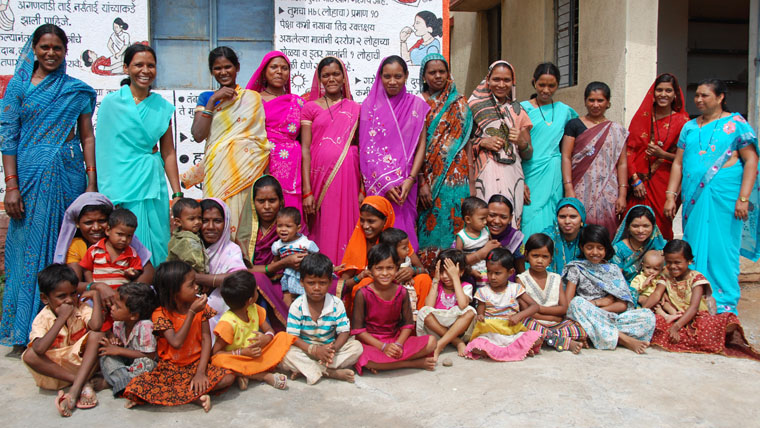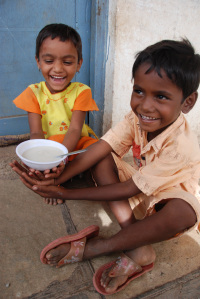The Masterchefs of Melghat

By Annila Harris, Communications Associate, World Vision India
Known for its high cases of malnutrition, the Melghat region of India became a focus for World Vision India in devising an innovative and engaging technique for beating the odds.
The concept, envisaged by World Vision India, sought to bring about change in the cooking habits of each and every household, hopefully leading to empowered and health-conscious cooking. Since women have had the responsibility for preparing and cooking for their households for generations, World Vision India are nurturing them to become local chefs who could cook their way out of malnutrition.
Operation Village Chef
Round one started with the declaration of a cooking contest with a twist: all those participating had to prepare a recipe that had high nutritional value, but could only be made of locally available produce.
Prashant Ingole, a Programme Officer with World Vision India, explains, “The best nutritious food recipes were to be showcased in a food exhibition. Self-help groups (SHGs) from the villages had to come up with creative and innovative recipes that were easy to make, utilised locally available ingredients and had high nutritional value.”
Keen to put their culinary skills to the test, women gathered together in their respective villages to brainstorm, with ideas pouring in. Some zeroed in on sweet dishes, others on savoury. As enticing recipes were chalked out the region of Melghat was converted into a giant kitchen, filled with the aroma of a wide array of mouth-watering, indigenous and health-conscious food.
Milky Issues
Women from Badnapur and Solamoh villages decided to attempt the unthinkable.
“The presence of livestock [in these villages] is minimal. Milk is a rare commodity. None of the families here have access to milk,” says Sushila, a community development coordinator of World Vision India.
From such milk-deprived villages the women challenged themselves to design a recipe for a milk-dependent rice pudding.
Since farming is one of the avenues to generate income, the land is used to grow crops like soybean. Despite plenty of soybean the women had no inkling that soy could be the answer to their milk crisis, until an anganwadi savika (a government sponsored child and mother-care center) empowered them with the knowledge of soymilk.
“We had heard that soymilk has a lot of protein and could be used to make milk tea but we never thought we could use it practically,” says SHG member Usha Subesh Mahalai, “No attempts were made to extract milk from soybean. It was only when World Vision India announced about the cooking contest that the women of the village got charged up. Determined to win we devised a recipe to use soymilk in the kheer (rice pudding). My kids love it.”
Learning from the first judging
At the end of round one, 15 SHGs were selected to undergo training from Anita Telang, a senior dietitian from Govt. Hospital Amravati. Anita analysed their food items and, without changing the core ingredients, she suggested certain tips/additions to increase the nutritional value of the dish. The women were also trained to understand the nutritional value (calories) of each ingredient present in the recipe.
For the first time the women were educated on the concept of nutritious food and the importance of healthy eating habits. Identifying the macronutrients and its calorific values were instilled among the new breed of highly motivated chefs. What had previously been alien concept now became an integral part of their routine, with the women including these health tips in their daily cooking.
“We used to soak the soybean and directly use it,” says Shanto Ravi Belsare, another mother involved in the project. “The madam informed us that it was not a good practice because the skin of the seed has unhealthy substances. She told us to remove the skin of the soybean and boil the soybean before milking it.”
The final reckoning
Finally 13 SHGs and their tantalising dishes were selected to be showcased in the one of a kind Nutrition Exhibition at Chikhaldara.
The dishes, printed in a booklet format with ingredients and calorific values, catered to the taste buds of all, ranging from Rajgira & Poshan Ladoo (amaranth grain and peanut sweet balls) in the sweet category to Kaddu Ka Parantha (pumpkin stuffed Indian bread) in savoury section. Locals flocked in from all over the Melghat region to witness this unique and inclusive initiative to battle malnutrition.

More than 300 pregnant and lactating mothers, newly-married women and adolescent girls were targeted through this initiative. Local colleges and schools also participated in the exhibition, extending their full support to the cause of eradicating malnutrition.
 After all their hard work the women of Badnapur’s ‘soybean milk kheer’ was the most appreciated dish of the day. The exhibition was also graced with the presence of government officials, mainly from the health-care sector, who highly commended the efforts of WV India.
After all their hard work the women of Badnapur’s ‘soybean milk kheer’ was the most appreciated dish of the day. The exhibition was also graced with the presence of government officials, mainly from the health-care sector, who highly commended the efforts of WV India.
The nutrition exhibition not only created awareness on how to cook nutritious meals but also started a trend of healthy eating practices using only locally available food material consumed on daily basis.
We love this story of education and ingenuity on the part of not just our colleagues in World Vision India for coming up with the contest, but all of the women involved who really challenged themselves to learn, grow and explore the possibilities of the resources they had available.
Check back on the blog on Thursday to hear about Phase 2 of the project and get the full soybean milk rice pudding recipe for yourself! And don’t forget you can leave your comments and questions on our Facebook page.